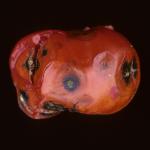Solanaceous, Anthracnose
Colletotrichum spp.
Anthracnose of tomato is primarily a disease of ripe and over-ripe fruit. If left unchecked, the disease can cause serious losses in yield and marketability. Caused by several species of the fungus Colletotrichum, the disease is widespread and common in areas where moisture conditions promote disease development. Anthracnose also affects eggplant, pepper, and potato. C. coccodes is the most common pathogen of tomato fruit.
Identification:
Symptoms are first noticeable on ripe fruit, although green fruit is also infected and these latent infections can become a serious post-harvest problem. Tiny lesions may also occur on leaves and stems, are usually overlooked, but can serve as an initial source of inoculum for fruit. Small, circular, sunken spots appear on ripe fruit and are characterized by numerous submerged, black microsclerotia often in concentric rings.
Life Cycle:
Although C. coccodes is considered to be a weak pathogen, many common weeds and crop plants are hosts and thus inoculum reservoirs. The pathogen overwinters as microsclerotia on seed, in the soil, and in infected plant debris and is spread by splashing rain and overhead irrigation. The disease is favored by warm temperatures (68-75° F), extended periods of leaf and fruit wetness, and free moisture. Fruit on plants partially defoliated by leaf diseases are particularly susceptible to infection.
Crop Injury:
Spots can coalesce and involve large areas of the fruit. Under humid conditions, spots darken due to the production of hairs (setae) on the fruiting bodies of the pathogen and pink, gelatinous masses of conidia may ooze from lesions. Lesions may crack and become invaded by secondary soft-rotting organisms.
Cultural Controls & Prevention:
- Start with certified, disease-free seed. Use fungicide treated seed or treat seed with hot water (122° F for 25 minutes).
- Rotate with non-solanaceous crops for at least one year.
- Keep fields free from weeds.
- Avoid excess overhead irrigation.
- Staking and mulching can reduce losses to anthracnose.
- Fungicide sprays provide acceptable control if applied on a regular schedule from first fruit set to harvest. Use weather based disease forecast model to schedule sprays (TOM-CAST).
Chemical Controls & Pesticides:
For Current information on disease recommendations ins specific crops including information on chemical control & pesticide management, please visit the New England Vegetable Management Guide website.
Crops that are affected by this disease:
The Center for Agriculture, Food and the Environment and UMass Extension are equal opportunity providers and employers, United States Department of Agriculture cooperating. Contact your local Extension office for information on disability accommodations. Contact the State Center Director’s Office if you have concerns related to discrimination, 413-545-4800 or see ag.umass.edu/civil-rights-information.



